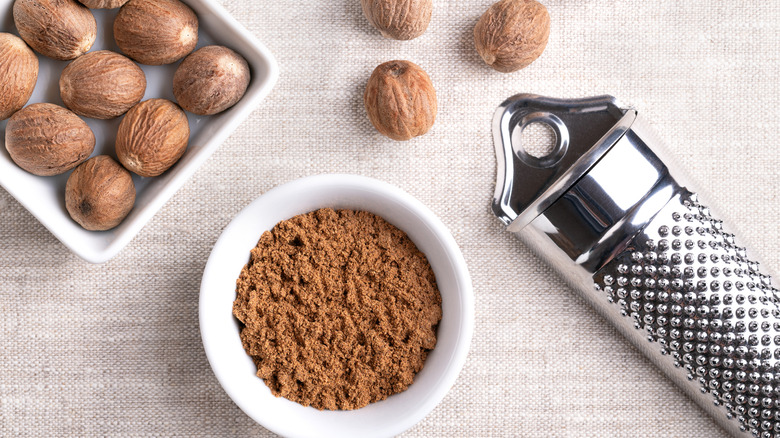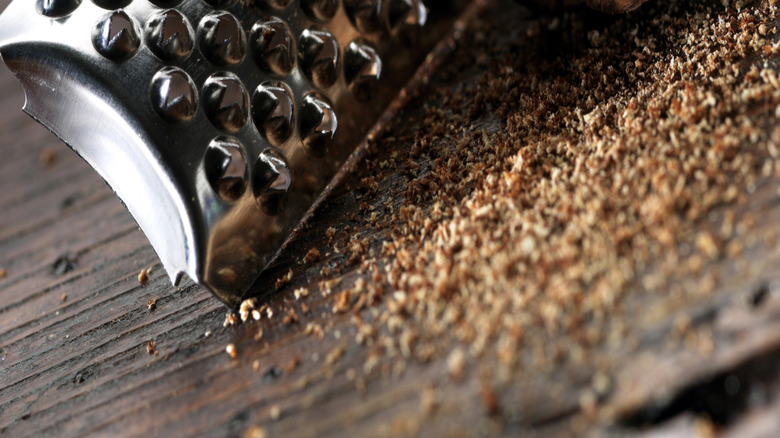Can Nutmeg Really Make You Hallucinate?
Although many spices have gained viral attention — such as cinnamon in the risky cinnamon challenge — nutmeg is one fewer people are aware of. A key ingredient in pumpkin spice and a zesty addition to Alfredo sauce, this spice isn't something most people would consider potentially dangerous. However, nutmeg has been linked to drug abuse since the 1960s, and in 2020, it gained attention on TikTok in a trend involving consuming large amounts to achieve a high. However, nutmeg's effects have been known about for much longer than that, with the first recorded case dating to 1576, wherein a pregnant English woman consumed 70 to 84 grams of nutmeg in an attempt to induce an intoxicated state.
While intoxication by ingesting nutmeg is possible, it is extremely dangerous. Moreover, it takes a fairly large amount — a minimum of five grams — making it something you must actively seek to consume, as the volume is much more than any recipe ever calls for. In 2000, the Journal of Toxicology: Clinical Toxicology published a study on the toxicology of nutmeg abuse and documented the case of a 13-year-old girl who ingested between 15 and 24 grams of nutmeg in three hours. Following consumption, the girl began displaying auditory, visual, and tactile hallucinations as well as bizarre behavior, nausea, blurred vision, numbness, and drowsiness.
Nutmeg's hallucinogenic properties are due to a mixture of compounds in the spice. In high doses, these compounds cause an intoxicating effect for which there is no cure. However, activated charcoal can be administered to help remove it from the digestive tract, as was the case with the 13-year-old patient from the toxicology study.
Why nutmeg causes hallucinations in high doses
The reason nutmeg, consumed in high doses, can induce intoxication is due to the compounds myristicin and elemicin. Myristicin is similar to MDMA, also known as ecstasy. It's a monoamine oxidase inhibitor, meaning it prevents the chemicals in the brain responsible for improving moods from breaking down. Interestingly enough, monoamine oxidase inhibitors were used as the first kind of antidepressant invented, but they've fallen out of favor over safety concerns and side effects. While this may not sound too bad, when metabolized, myristicin can form amphetamine derivatives and mimic anticholinergic toxicity, resulting in symptoms like flushing, fever, urinary retention, hallucinations, restlessness, confusion, agitation, delirium, and seizures, to name just a few.
Similarly, elemicin also has hallucinogenic properties and can act as an anticholinergic. This compound is structurally similar to the psychedelic mescaline, a naturally occurring alkaloid most notably found in peyote cactus. It's a psychedelic that's been used by Native Americans during religious ceremonies for thousands of years and is largely not illegal in the United States.
Ingesting these two compounds in a large amount of nutmeg can lead to several issues, and the intoxication can take hours to set in and last for days. Along with hallucinations, some of the most common effects of nutmeg intoxication are drowsiness, dizziness, and confusion. However, other side effects can include respiratory and cardiovascular distress and gastric distress. So while you should totally use nutmeg in your homemade pumpkin spice lattes, just remember that less is best with this spice.

